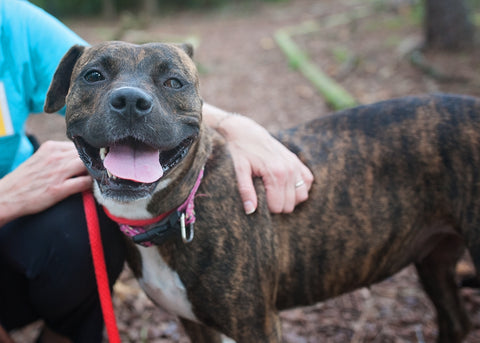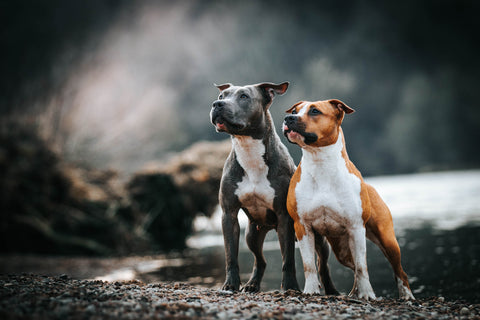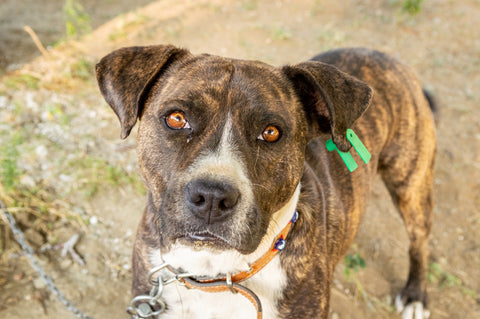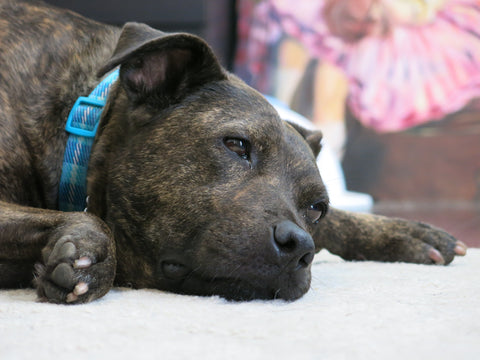Activity Level: High
Hypoallergenic: No
Social Ability: Selectively Social
Skills: Obedience, Weight-Pulling, Guarding
Intelligence: Above Average
Ideal Climate: Warm
American Pit Bull Terriers, Pit Terriers, and American Staffordshire Terriers, collectively called Pit Bulls, can bring an incredible sweetness to any home. Their loyalty, obedience, and trainability make them outstanding companions; they have earned the ‘nanny dog’ title for their caring nature, and they love to play with friends of all species. Poor training, misinformation, and unfortunate circumstances have left Pit Bulls with a checkered reputation, but with standard training and a loving home, these dogs can live healthy, happy lives like any other breed.
Breed Overview
 Origin: Bred from Bull and Terrier breeds, Pit Bulls can be traced back to the nineteenth century in the UK. With a genetic disposition for a lithe and strong physique, they filled roles as bull and cattle dogs, along with many more skills to contribute to farms, ranches, and homesteads. Their innate loyalty and eagerness to please solidified their place in humans’ hearts, and over the years they became common family pets. These highly vigilant Pit Bulls showed great care with their pack and a gentle nature with humans of all ages, earning the nickname of ‘nanny dogs’ which prevails to this day.
Origin: Bred from Bull and Terrier breeds, Pit Bulls can be traced back to the nineteenth century in the UK. With a genetic disposition for a lithe and strong physique, they filled roles as bull and cattle dogs, along with many more skills to contribute to farms, ranches, and homesteads. Their innate loyalty and eagerness to please solidified their place in humans’ hearts, and over the years they became common family pets. These highly vigilant Pit Bulls showed great care with their pack and a gentle nature with humans of all ages, earning the nickname of ‘nanny dogs’ which prevails to this day.
History: Countless studies (including a 2008 study from Applied Animal Behaviour Science, the American Temperament Test Society’s independent test of over 31,000 dogs, and a study published by pediatric researchers at CDC), and many organizations (including ASPCA, Pet WebMD, and the National Canine Research Council), agree that no breed, including Pit Bull, is inherently aggressive or malicious. Rather, their human owners may unfortunately train them to be so, or the dog may be exhibiting a natural response to a perceived threat. Regardless of the situation, no dog deserved to be judged by its breed.
From the outset, the Pit Bull breed exhibited natural skills in many canine tasks such as hunting, pulling, and guarding. Seeing their potential, owners and breeders placed them in service positions throughout aristocratic and agricultural spaces. Over the nineteenth and twentieth centuries, they became companion animals, service dogs, and more. During World War II, Pit Bulls were an American symbol of patriotism and power, as these canines were regarded as brave and loyal and often used in combat. Post-war America welcomed this breed into their homes and hearts, until things started to change. But first, the history of the Pit Bull and the breed’s role in dogfighting must be understood from its origin.
 Dating back to the Roman Empire, dogfighting is a blood sport in which humans pit canines against each other in fights for entertainment and gambling. Fighting dogs were typically Mastiffs or an ancient breed called Molossus, which resembled a thicker-furred Labrador, though its history is not entirely clear due to mistranslations of Grecian writings. The cultural phenomenon of blood sports was not limited to dogs; many animals including roosters and bulls were made to fight for entertainment.
Dating back to the Roman Empire, dogfighting is a blood sport in which humans pit canines against each other in fights for entertainment and gambling. Fighting dogs were typically Mastiffs or an ancient breed called Molossus, which resembled a thicker-furred Labrador, though its history is not entirely clear due to mistranslations of Grecian writings. The cultural phenomenon of blood sports was not limited to dogs; many animals including roosters and bulls were made to fight for entertainment.
In this era and for many decades to come, dogfighting was not only accepted but embraced, bringing spectators from counties over to gather in crowded colosseums and arenas. The owners and trainers of these animals were regarded as powerful, respectable men in society at the time. The sport was practiced on multiple continents for centuries before it was brought to the US around 1750, over six decades before the American Staffordshire Bull Terrier was introduced. In spite of pushback from activists of several eras, the practice would continue in the country for many decades as an underground yet widely practiced activity. By the end of the Civil War in 1865, American culture had all but accepted the sport, though it would not reach the height of popularity it saw in its early decades.
Over a century later, dogfighting was officially outlawed in the US in 1976. There was a small resurgence of the practice including Pits and other breeds, and in turn Pits became the breed associated with criminality and aggression. Furthering this perception, in the 1980s both Time Magazine and Sports Illustrated published content affirming the notion of Pit Bulls being an irrevocably aggressive breed.
 Two decades after the bad press hit a fever pitch in 2004, defamed sportsman Michael Vick’s illegal kennels were raided. The rescued dogs, who were trained by humans to fight, were given a second chance. The light at the end of the long, winding tunnel for Pit Bulls, and all fighting dogs for that matter, came in the form of numerous animal rights groups re-training, fostering, and re-homing them with caring owners. President Obama would later sign the Farm Bill to officially criminalize attendance to the event as well.
Two decades after the bad press hit a fever pitch in 2004, defamed sportsman Michael Vick’s illegal kennels were raided. The rescued dogs, who were trained by humans to fight, were given a second chance. The light at the end of the long, winding tunnel for Pit Bulls, and all fighting dogs for that matter, came in the form of numerous animal rights groups re-training, fostering, and re-homing them with caring owners. President Obama would later sign the Farm Bill to officially criminalize attendance to the event as well.
In a monumental move for the fair treatment of all animals, the ASPCA participated in one of the US’s largest dog fighting raids in 2009, freeing over 400 Pit Bulls and leading to 26 arrests. As well, two influential groups, the San Francisco Society for the Prevention of Cruelty to Animals and the Animal Care Center of NYC, have made efforts in supporting Pits’ rights and fighting legislation restricting the breed in specific states.
These activists and animal caregivers are on the front lines of the fight for Pitties’ rights, helping spread true, science-backed information about these sweet canines and their rightful place among other beloved breeds. For more information on the temperament of the average Pit, read more in the Breed Attributed section below. Though the Pit Bull’s history may still follow it to some degree, the future is bright for these canines. One of many organizations helping Pitties out is Villalobos Rescue Center, an all-breed rescue focusing on Pit Bulls as well as employing parolees, promoting fair treatment of all on their Animal Planet show. Growing love and acceptance for this breed is helping get these dogs out of shelters and placed where they belong– home
Breed Attributes
 Temperament: Pit Bulls are incredibly loyal to their pack, whether that includes humans, other dogs, and even other species. They can be territorial and get defensive if threatened, but not necessarily more so than other willful breeds. With proper training and care, Pits can be sweet, calm dogs. As mentioned above, they are not inherently aggressive or dangerous; they are simply very strong and loyal. Therefore, strong leadership from their owner is essential, as it is for many breeds.
Temperament: Pit Bulls are incredibly loyal to their pack, whether that includes humans, other dogs, and even other species. They can be territorial and get defensive if threatened, but not necessarily more so than other willful breeds. With proper training and care, Pits can be sweet, calm dogs. As mentioned above, they are not inherently aggressive or dangerous; they are simply very strong and loyal. Therefore, strong leadership from their owner is essential, as it is for many breeds.
Numerous studies have shown that a dog’s personality, temperament, and habits are a product of both nurture (the care and direction given by their owner) as well as nature (their natural insticts). In recent years, an increasing number of people have accepted the concept that both nature and nurture play a role in a dog’s disposition, and the negative connotation following the breed is starting to fade into the past. Now, Pitties can be found in loving homes, on farms, and in service jobs all over the world.
*It is important to note that for any dog of any breed, proper training is a crucial part of building an obedient, calm temperament. As well, all children should be taught how to interact with and respect animals prior to meeting any pet.*
Personality: Pit Bulls are inherently eager to please their owner, therefore early obedience training may help them follow orders at their human’s side. Their high level of intelligence gives them an advantage as guard or nanny canines as well, where they can also exhibit a gentle nature becoming of an adorable Pittie. While every dog is different, this breed generally possesses a sweet disposition and an excitable energy level.
Ideal Owner: You! Pit Bulls play hard and love harder, so they can thrive as companions or service animals in just about any environment. That being said, Pits are one of many breeds that need strong leadership from their owner, and it is recommended to gain experience with large and strong-willed dogs before adopting a Pit Bull.
Fur Care

Grooming: The smooth, glossy coat of a brindle Pittie is easy to groom with a firm bristle brush. Regular brushing can help keep skin healthy by encouraging blood flow and exfoliating dead skin, and grooming can be a bonding experience for dog and owner. Occasional baths or use of dry shampoo will help keep your pet clean and their skin healthy.
Dermatological Health: All varieties of Pit Bulls may be predisposed to skin issues including eczema and chronic dry, flaking skin. The American Staffordshire Bull Terrier in particular is prone to a serious skin condition called Zinc-Responsive Dermatosis, which is related to a Zinc deficiency in their diet. A veterinarian’s examination may be necessary if your Pittie exhibits undue skin irritation.
Shedding: Pits exhibit a moderate level of shedding, therefore they are not hypoallergenic. Excessive shedding may be a sign of a nutritional imbalance, and an Omega 3 Supplement added to their diet can help nourish skin and fur health by helping replenish moisture and maintain elasticity.
Health
 Common Issues: Due to their combination of both terrier and bulldog genetics, common Pit Bull health problems may include predispositions inherited from their parents or ancestors. Heart disease is common among many breeds, even with a healthy diet and plenty of exercise, and ocular conditions such as Cataracts may affect this breed more than others as well. Regular veterinarian examinations are recommended to check for possible warning signs of all congenital conditions.
Common Issues: Due to their combination of both terrier and bulldog genetics, common Pit Bull health problems may include predispositions inherited from their parents or ancestors. Heart disease is common among many breeds, even with a healthy diet and plenty of exercise, and ocular conditions such as Cataracts may affect this breed more than others as well. Regular veterinarian examinations are recommended to check for possible warning signs of all congenital conditions.
Many breeds of all sizes and activity levels may be prone to joint or hip dysplasia, a genetic abnormality in joint tissue causing slippage and discomfort. A Pit Bull’s activity level is higher than average, needing at least one walk and one play session every day, so their joint health should be monitored. Joint-supporting supplements such as Z-Flex with Glucosamine are great additions to a balanced diet and support healthy, flexible joints.
Cancer in Pit Bulls is a common concern, however this breed is no more prone to cancerous growth than the average dog. Pits have about a 1 in 4 chance of getting cancer during their adult years, and those diagnosed typically show mast cell and other skin tumors. A veterinarian must address concerns about cancer, so do not hesitate to reach out for a professional opinion– your dog’s health is worth it.
 Pits also tend to have sensitive skin and may be predisposed to skin allergies such as grass, common cleaners, and certain fabrics. A moderately serious result of an allergic reaction called Contact Dermatitis is one of the most common reasons for veterinarian office visits according to Healthy Paws Pet Insurance & Foundation in 2018. While some skin problems may be addressed at home with over-the-counter products, a vet’s examination may be necessary.
Pits also tend to have sensitive skin and may be predisposed to skin allergies such as grass, common cleaners, and certain fabrics. A moderately serious result of an allergic reaction called Contact Dermatitis is one of the most common reasons for veterinarian office visits according to Healthy Paws Pet Insurance & Foundation in 2018. While some skin problems may be addressed at home with over-the-counter products, a vet’s examination may be necessary.
Nutrition: Plenty of exercise means plenty of food, but be mindful to monitor your Pit’s consumption. This breed requires average amounts of proteins, fats, and carbohydrates, and they should be fed according to their veterinarian’s instruction to help them stay in shape. All dogs need high-quality food, as their diet is their source of many essential nutrients, but a canine multivitamin can help fill the gaps in their diet without changing their diet or switching to more expensive pet food.
Lifespan: 8-15 years
Physical Activity
 Training: Early training is essential for all dogs and maybe more so for Pit Bulls. After many years of studies and in gaining a new understanding of these canines, most veterinarians and dog experts agree that they are not inherently aggressive. Due to their high intelligence and willful personality, Pits simply require more consistent enforcement and training than the average breed needs to build a calm temperament.
Training: Early training is essential for all dogs and maybe more so for Pit Bulls. After many years of studies and in gaining a new understanding of these canines, most veterinarians and dog experts agree that they are not inherently aggressive. Due to their high intelligence and willful personality, Pits simply require more consistent enforcement and training than the average breed needs to build a calm temperament.
Training any dog at an early age is a great way to get them accustomed to obedience from their owner and other humans. Many veterinarians recommend trying a variety of training tactics to see what works best for each individual dog.
Exercise: These active canines require plenty of daily exercise and long walks, but they can thrive with or without a yard. Many dogs of all high-energy breeds can experience anxiety when stuck at home; to help combat this pent-up energy turning into destructive behavior, direct their attention to a tasty, chewy, or puzzling toy.

Pit Bull Terriers of all shapes and sizes are excitable, sweet, and ready to play. With a loving home, ample training, and plenty of toys, your Pittie can thrive with a big or small family of any species.

